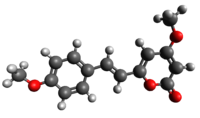Yangonin facts for kids
Quick facts for kids Yangonin |
|
|---|---|
 |
|
 |
|
|
Preferred IUPAC name
4-Methoxy-6-[(E)-2-(4-methoxyphenyl)ethen-1-yl]-2H-pyran-2-one
|
|
| Identifiers | |
| CAS number | |
| PubChem | |
| SMILES | COC1=CC=C(C=C1)/C=C/C2=CC(=CC(=O)O2)OC |
|
InChI
InChI=1/C15H14O4/c1-17-12-6-3-11(4-7-12)5-8-13-9-14(18-2)10-15(16)19-13/h3-10H,1-2H3/b8-5+
|
|
| Properties | |
| Molecular formula | |
| Molar mass | 0 g mol-1 |
| Except where noted otherwise, data are given for materials in their standard state (at 25 °C, 100 kPa) | |
Yangonin is a special natural chemical found in the kava plant. It is one of six main chemicals called kavalactones that are in kava.
Scientists have studied yangonin to see how it affects the body. They found it can connect with a part of our brain called the cannabinoid receptor CB1. This connection might help explain some of the calming effects of traditional kava drinks. Yangonin also seems to affect other systems in the body, like those involved in mood.
How Yangonin is Made in Plants
Yangonin is made naturally inside the kava plant. This process is called biosynthesis. The plant uses smaller building blocks, like coumaroyl-CoA and malonyl-CoA, to create yangonin.
How Yangonin Affects Cells
Scientists have also looked at how yangonin affects human cells in lab tests. These tests showed that yangonin can change how some liver cells behave. It's important to remember that these are lab studies, and the effects in a living body can be different.
Images for kids




